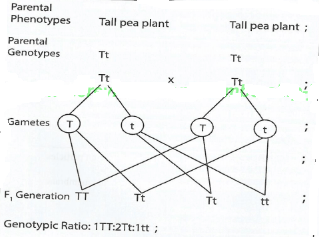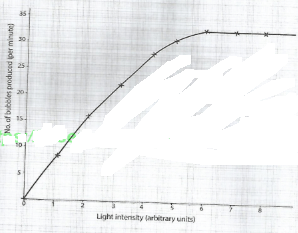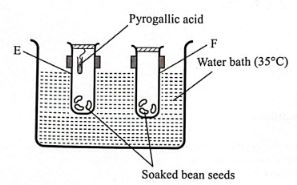SECTION A (40 marks)
Answer all the questions in this section in the spaces provided.
- The set-up below was used to investigate a certain factor necessary for seed germination.
-
- Identify the factor under investigation. (1 mark)
- Give a reason for your answer in 1(a)(i) (1mark)
- Explain why it was necessary to:
- maintain the water bath at 35°C (1 mark)
- use soaked bean seeds (1mark)
-
- Explain the expected observations at the end of the experiment in test tubes E and F. (2 marks)
- Explain what is likely to happen if set-up F was maintained for 7 days. (2 marks)
-
- A fresh water lake surrounded by agricultural farms has the following organisms:
Fish
Hippopotamus
Reeds
Algae- State the roles of each of the following organisms in the lake ecosystem:
- hippopotamus (2 marks)
- algae (2 marks)
- Explain the likely positive and negative effects of the surrounding agricultural farms on the lake ecosystem.
- Positive effects (2 marks)
- Negative effects (2 marks)
- State the roles of each of the following organisms in the lake ecosystem:
-
- Two tall garden pea plants were crossed and of the resulting offspring, 750 were tall and 250 were short. Using letter T to represent the dominant gene, determine the genotypic ratio of the off-spring. (5 marks)
- Besides height in the garden pea plants, state two other contrasting seed traits that Mendel focused on in his genetic studies. (2 marks)
- State how the genetic knowledge has been used to improve pea plant farming. (1 mark)
-
- Explain how each of the following factors affect uptake of mineral ions in plants:
- temperature (3 marks)
- glucose concentration in root hair cell sap (3 marks)
- State two characteristics of the root hairs that increase their surface area for absorption of mineral ions. (2 marks)
- Explain how each of the following factors affect uptake of mineral ions in plants:
-
- State two main functions of the ear ossicles. (2 marks)
- Explain how each of the following parts of the ear are structurally adapted to their functions:
- tymphanic membrane (1 mark)
- cochlea (1 mark)
- State the function of the eustachian tube in the mammalian ear. (1 mark)
- State the importance of each of the following in the mammalian ear:
- wax (1 mark)
- endolymph and perilymph (2 marks
SECTION B (40 marks)
Answer question 6 (compulsory) and either question 7 or 8 in the space provided after question 8.
- A shoot of an aquatic plant was exposed to different light intensities and the rate of photosynthesis estimated by counting the number of bubbles of a gas leaving the shoot per minute. The results were tabulated as shown below.
No. of bubbles per minute 0 9 16 22 28 31 32 32 32 Light intensity (arbitrary units) 0 1 2 3 4 5 6 7 8 - On the grid below, draw the graph of the number of bubbles produced per minute against light intensity. (6 marks)
- State how the identity of the gas produced can be determined in the laboratory. (I mark)
- Name the apparatus used for measuring light intensity. (1 mark)
- Why was it necessary to get the shoot from an aquatic plant? (1 mark)
- Account for the number of bubbles produced between the following units of light intensities.
- 0-6 (3 marks)
- 6-8(3 marks)
- State two modifications one would make on the experimental set up to increase the rate of gas bubble production. (2 marks)
- Explain the limitations of using gas bubbles to determine the rate of photosynthesis. (2 marks)
- With a reason, predict the number of bubbles that would have been produced at 15 units of light intensity. (1 mark)
-
- Describe how plants eliminate waste products. (8 marks)
- Describe the structure and function of the mammalian nephron. (12 marks)
-
- Describe five tropic responses in plants and their survival values. (15 marks)
- Describe how the mammalian heart beat is controlled. (5 marks)
MARKING SCHEME
-
-
- Oxygen (is necessary for seed germination);
- Presence/inclusion of pyrogallic acid (in set-up E) absorbs oxygen in experimental set-ups);
-
- (35°C) is the optimum temperature required for functioning of (most) enzymes;
- To soften the seed coat/testa (for ease of emergence of the radicle)/ water activates germination enzymes/hydrolyses stored food/enhancing the rate of germination/solvent/medium of transport;
-
-
- Set-up E- germination will not occur due to lack of energy/ oxygen;
- Set-up F-germination will take place since the seed coat/testa is softened/there is oxygen (that was initially in the apparatus)/ temperature is optimum;
- Germination/growth process stagnates/slows down then seedlings wither/die/dry up; the oxygen/moisture in the test tube will be depleted;
-
-
-
-
- Hippopotamus exhale carbon (IV) oxide which is used up by the algae/reeds to photosynthesize; their dung released into the water enriches it, favouring the growth of algae/ phytoplanktons/reeds; the dung is also fed on by fish;
- Algae are the primary producers for the lake ecosystem; release oxygen for use by organisms (in the lake ecosystem); purifies the ecosystem by using up the carbon (IV) oxide (produced by the fish/hippopotamus/other animals; regulates the pH of the water-by using up the carbon (IV) oxide; provide breeding grounds for fish; algae is fed on by fish/hippopotamus;
-
- Portions of fertilizers\/organic manure applied on the farms find themselves deposited in the lake (due to surface run-off/ siltation); enriching the lake ecosystem, favouring growth of plants/algae/phytoplanktons(in the lake ecosystem);
-
- Excessive use of fertilizers/organic manure on the farms and their eventual deposition into lake ecosystem into the lake ecosystem results in nthe overgrowth of phytoplanktons/leads to eutrophication;
- Some agrochemicals (pesticides/herbicides) used in the farms may be toxic/poisonous to the aquatic organisms;
- Extensive surface run-off/soil erosion and deposition into the ake blocks/clogs gaseous exchange surfaces of aquatic life; it increases turbidity, reducing visibility/light penetration in the water;
-
-
-

Accept correctly done Punnet square -
- Texture (of seed coat);
- Colour (of seed coat/cotyledon/ testa);
- Form/shape of the seed;
- Artificial selection/ cross breeding/ polyploidy/ genetic engineering (resulting in varieties with desirable traits);
-
-
- At temperatures below optimum, the rate (of mineral ions uptake) is slow due to inactive respiratory enzymes; at optimum temperature, the rate (of mineral ions uptake) is highest since respiratory enzymes are most active; at temperatures beyond optimum, the rate (of mineral ions uptake) slows since the respiratory enzymes are destroyed/denatured;
- Glucose is a respiratory substrate (which when oxidized releases energy); needed for active uptake of mineral ions; high glucose concentration produces more energy; while low glucose concentration produces less energy;
-
- Are long/elongated (to penetrate through the soil) to reach more mineral ions;
- Are numerous/ many;
-
-
-
- Transmission of sound vibrations (from the tympanic membrane to the oval window);
- Amplification of sound vibrations;
-
- Thin/tight/pliable membrane that vibrates/converts sound waves into vibrations;
-
- Highly coiled to accommodate a larger number of sensory cells;
- Has numerous sensory cells (to perceive sound vibrations)
- Filled with a fluid to enhance transmission of sound vibrations;
- To balance pressure between the atmosphere and middle ear/on both sides of the eardrum/middle and outer ear;
-
-
- Trap dust particles/prevent entry of solid/ foreign particles/ bacteria/(micro)organisms;
- Maintain the pliability/ flexibility of tymphanic membrane;
-
- Absorbs (mechanical) shock;
- Transmission of vibrations in the inner ear;
-
-
-
-

Plotting(P) - 1 mark
Labelling axes (L) - 2 marks
Smooth curve (SC) - 1 mark
Scale (S) - 2 marks
Total 6 marks - (Using a glowing splint) it relights a glowing splint;
- Photometre/light metre/ exposure metre/ photographic light metre;
- Aquatic plants are adapted to photosysnthesizing under the water/ in low light intensity; it can utilize carbon(IV)oxide in solution form; it is easier to collect the gas produced by aquatic plants under the water; OWTTE
-
- Rapid increase in the number of bubbles produced; due to increased light intensity which increased the rate of photosynthesis;
- Number of bubbles produced remain constant; since the rate of photosynthesis had reached the maximum; due to optimum light intensity; other factors (such as carbon (IV) had oxide concentration) became limiting;
-
- Supply sodium hydrogen carbonates in the set-up/ any other source of carbon (IV) oxide;
- Increase the number of shoots of aquatic plants;
- Increase temperature to optimum;
- Photosynthesis and respiration occur simultaneously in plants/gases produced during one process are used in the other; not all bubbles may be accounted for/some gas dissolves in the water;
- 32 or any other value less than 32 but not more than 32, photosynthesis had reached the peak/maximum/less than 32-bleaching of chlorophyll;
-
-
-
- Plants eliminate vapour through the stoma/cuticle/lenticels during the process of transpiration;
- Some other wastes are eliminated in form of gases (oxygen/carbon (IV) oxide through diffusion/through lenticels/ stoma/ pneumatophores during photosynthesis;
- Some plants also get rid of excess water in form of water droplets-jor guttation through hydathodes in their leaves;
- Some plants eliminate their wastes by shedding their leaves;
- Plants also recycle/reuse their wastes, for instance the carbon (IV) oxide produced during respiration being used in photosynthesis; as the oxygen produced during photosynthesis is used up during respiration; Other plants store their wastes in vacuoles; while others deposit them in stems/roots;
- Some waste products like gum, resins, oils are removed by exudation through the bark;
Max - 8 marks
-
- It has kidney/renal tubule; and glomerulus/ a network of blood capillaries;
- Bowman's capsule; (with a capsular space between inner and outer wall); and a glomerulus where ultrafiltration occurs; due to the difference in diameters of the blood vessels serving it; afferent vessel (wider lumen); and efferent vessel (narrower lumen);
- The proximal convoluted tubule; extend from the Bowman's capsule. The filtrate flows through the proximal convoluted tubule where useful substances/ glucose, amino acids, some water and mineral salts/ ions are selectively reabsorbed into the bloodstream; by diffusion/active transport;
- Ascending and descending/The Loop of Henle has a descending arm for water reabsoption; and an ascending arm where salts are reabsorbed;
- The (filtrate empties into the) distal convoluted tubule; where (more) water is reabsorbed into the blood by osmosis/under the influence of Antidiuretic Hormone (ADH) and (more) mineral salts are reabsorbed by diffusion/active transport under the influence of aldosterone;
Max-12 marks
-
-
-
- Phototropism; growth curvature in response to direction/ unidirectional light; shoots are positively phototropic while roots are negative; phototropism enables plant shoots reach light for photosynthesis;
- Chemotropism; is growth response to a gradient of chemical substance/mineral ions/salts concentration; for instance, the growth of pollen tube towards the embryo sac for fertilization/ growth of roots towards certain mineral salts (for absorption);
- Geotropism; is the growth response to gravity; shoots are negatively geotropic while roots are positively geotropic; geotropism enables the roots reach water/mineral ions for absorption/enables roots to grow into the soil for anchorage;
- Hydrotropism; is the growth response to water? moisture-joi roots are positively hydrotropic, enabling roots reach water for absorption;
- Thigmotropism/haptotropism; is the growth response due to contact with solid objects; observed in climbing stems/ tendrils/plants with weaker stems to enable them reach light for photosynthesis/exposing flowers for pollination/fruit dispersal; Max-15 marks
- Mammalian heartbeat is controlled in two ways, non-nervous; and through nervous control;
During the non-nervous control, the cardiac muscles are myogenic/ initiate their own contractions/relaxations;(stimulation/electrical charges/excitations originate from within, in the Sino Atrial Node (SAN), stimulus/ excitation spreads through auricles leading to their contraction, stimulus/ excitation proceeds to the atrioventricular node into the Purkinje tissue to all ventricles (right/left) which contract; During the nervous control, the blood pressure and chemical composition of blood is monitored by the cardiovascular centre of the brain;/the heartbeat rate can be increased through sympathetic nerve; heartbeat rate lowered through vagus nerve/parasympathetic nerve;
-
Download BIOLOGY Paper 2 Questions and Answers - KCSE 2022 Past Papers.
Tap Here to Download for 50/-
Get on WhatsApp for 50/-
Why download?
- ✔ To read offline at any time.
- ✔ To Print at your convenience
- ✔ Share Easily with Friends / Students

